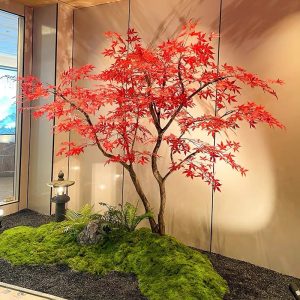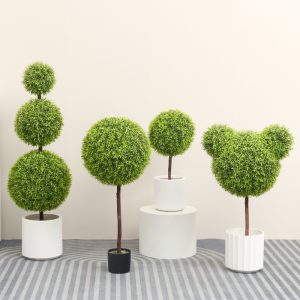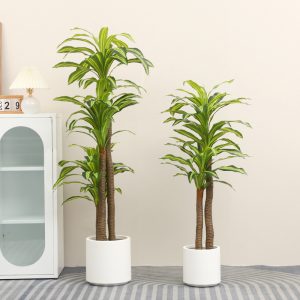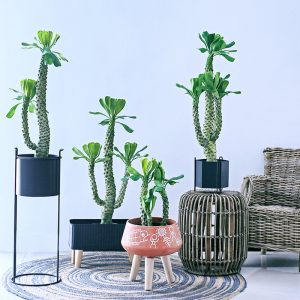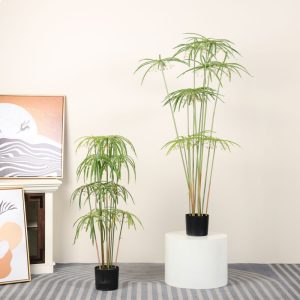On an early autumn morning in the countryside near Siena, Italy, sunlight filtered through thin clouds and fell softly over a garden restaurant. A breeze carrying the scent of lavender brushed past the stone walls, rustling the leaves by the flowerbeds. Watching gardener Giovanni polish the trunk, he laughed and said: “These artificial fig trees for landscape look unbelievably real!”
Landscape designer Luca touched the leaves, his fingers tracing their velvety texture. He turned back in surprise: “Even after three days of heavy rain, they haven’t deformed. The leaves are still as flexible as when first installed, with veins so clear they look just like a real fig tree.”
The garden was filled with the aroma of freshly baked bread and tomato-basil sauce, evoking the warmth of an old farmhouse courtyard. In the 200-square-meter landscape, several garden decorative artificial fig trees were arranged in layers: a tall tree with textured bark and green-yellow “fruits” at the entrance; medium-sized fake fig trees surrounding wooden tables by the lawn; and small models under the gazebo, swaying gently in the wind and light—together forming a picturesque Tuscan scene.
Light & Texture: Detailing the Artificial Fig Tree Landscape
Luca closely examined the joints between leaves and branches, marveling that even insect bites had been perfectly replicated. Up close, the leaves revealed a UV-resistant coating, giving a soft matte sheen under sunlight—without the cheap plastic glare. The touch was flexible, with velvety undersides and naturally curled edges, almost indistinguishable from real foliage.
Restaurant manager Sofia also shared guest feedback: “Since we replaced our old trees with these outdoor artificial fig trees, everyone assumes we hired a team to maintain a private orchard. With real trees, falling fruit and leaves created endless cleaning work, but now it’s completely worry-free.”

Rational Choice: Why Businesses Prefer Artificial Fig Trees for Landscape
Luca explained how the restaurant owner once doubted that “fake trees could capture real atmosphere”—until testing results proved otherwise. Real fig trees turned yellow in just three months, while the garden decorative artificial fig tree maintained vibrant color and flexibility even under strong sunlight.
Property supervisor Marco confirmed from records: “Maintaining real trees used to cost €700 per month. Now, with these high-simulation artificial fig trees, we only wipe them down once a week—almost zero maintenance. Even typhoons caused no damage. This durability is critical in commercial landscapes.”
Procurement consultant Elena added: “These artificial fig trees for outdoor decoration are made from eco-friendly materials, UV- and fire-resistant, and certified under EU standards. They’re safe even for children to touch. Their weather resistance ranges from -15°C to 65°C, making them suitable from Northern Europe’s winters to Southern Europe’s summers.”
Aesthetic All Day: From Sunrise to Nightfall
At sunset, the leaves gleamed with golden light, their reflections shimmering on the water. By night, under string lights and spotlights, the fake fig tree landscape became even more romantic, with guests lining up to take photos. The next morning, dewdrops rolled off easily when the gardener rinsed them, leaving no watermarks—easier to maintain than real trees.
More Than Decoration: The Emotional Value of Artificial Fig Trees
Retired farm owner Mrs. Rossi studied the tree through a magnifying glass and praised: “The cracks and fuzz are just like the real thing—and it even keeps bearing fruit through winter!” Wedding planner Sara highlighted its “harvest symbolism”: no leaf fall, no pests, no allergies—perfect for wedding photography.
Children played beneath the branches, reaching for the “fruit.” At that moment, it was clear: the garden landscape artificial fig tree is more than decoration—it brings the warmth and relaxation of the countryside to urban life.
Conclusion
For European and American B2B clients, the best outdoor plants are not those that look “as real as possible,” but those that “combine natural atmosphere with effortless maintenance.” These courtyard landscape artificial fig trees require no daily upkeep, yet stay evergreen with lush fruits all year round. From restaurants and hotels to malls and private courtyards, they consistently deliver a pastoral charm.
Wherever they stand—whether in the chill of winter or the heat of summer—they instantly create a sense of “harvest warmth,” inviting guests to linger and return.








